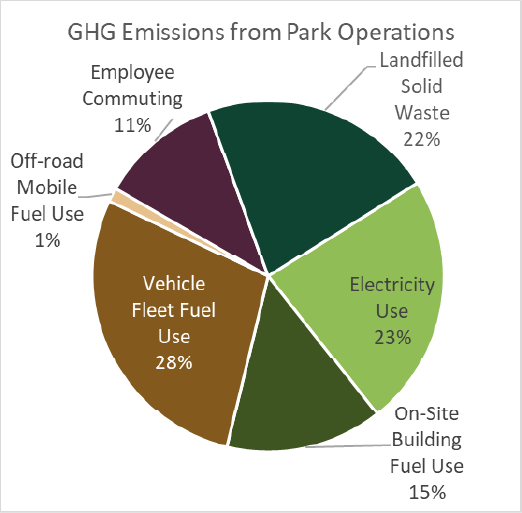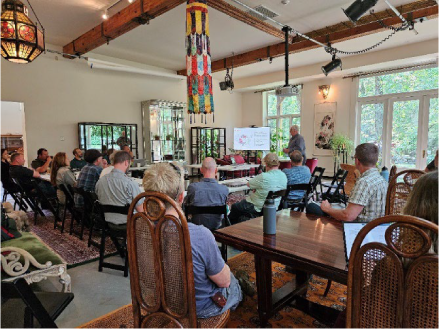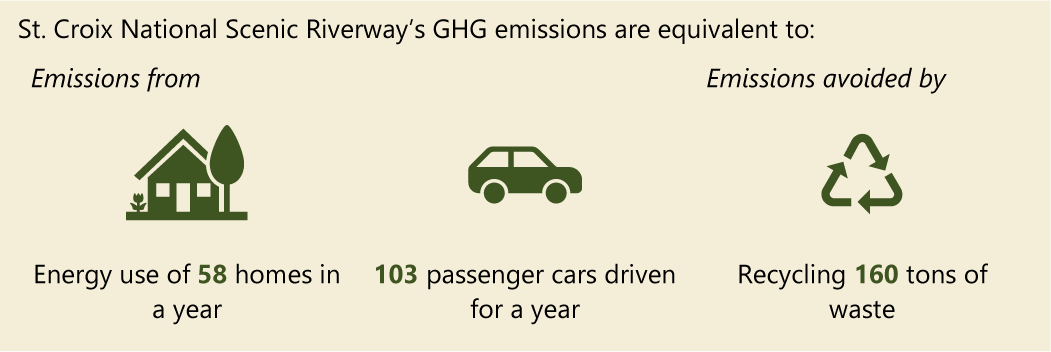Letter from the SuperintendentSt. Croix National Scenic Riverway preserves, protects, enhances, and interprets the Riverway’s exceptional natural and cultural resources for the enjoyment of present and future generations. As a steward of these diverse and special resources, our goal is to continually seek innovative and environmentally sound ways to protect and maintain the Riverway and its watershed. The Park is further committing to advance sustainability in its operations and visitor engagement through participation in the Climate Friendly Parks program. This document includes specific targets and actions that the Park will take to reduce its contribution to climate change, measure and reduce its environmental impact, and engage with visitors and partners on the Park’s sustainability efforts and what they can do to support the targets in this plan. As a Climate Friendly Park, St. Croix National Scenic Riverway commits to reduce the Park’s greenhouse gas emissions, improve energy and water efficiency, reduce waste sent to landfills, and maintain an active internal and external engagements on sustainability and climate change. Executive SummarySt. Croix National Scenic Riverway is committed to protecting and preserving its natural, cultural, and archeological resources through environmental stewardship as mandated by the Organic Act and the Park’s enabling legislation. As part of this commitment, St. Croix National Scenic Riverway is striving to become a Climate Friendly Park (CFP). As a CFP, St. Croix National Scenic Riverway will join a network of more than 140 parks nationwide that put climate friendly behavior at the forefront of park operations and resource management. To become a certified CFP, St. Croix National Scenic Riverway developed a greenhouse gas (GHG) emission inventory of its operations, participated in a climate change and sustainability educational workshop, set GHG emission reduction targets, and integrated these actions into a park-wide climate action plan (this document). Workshop OverviewIn August 2023, St. Croix National Scenic Riverway hosted a two-day Climate Friendly Parks workshop to discuss the Park’s current and future sustainability actions. The workshop featured speakers on:
Park AccomplishmentsThe Park has already undertaken efforts to improve sustainability, outlined in the table below.

NPS Park Greenhouse Gas (GHG) Emissions and Sustainability PerformanceSt. Croix National Scenic Riverway estimated greenhouse gas emissions that result from its operations using the Climate Leadership in Parks (CLIP) tool. Having this 2022 baseline helps inform the Park’s targets and actions we are taking to meet those targets. In 2022, the Park emitted approximately 474 metric tons of CO2 equivalent (MTCO2e) from its operations. The Park’s largest sources of GHG emissions in 2022 were vehicle fleet fuel use followed by purchased electricity use in buildings (see Figure 1). The Park operates 31 on-road vehicles to maintain and operate within its more than 250 miles of Riverway. Climate Action PlanSt. Croix National Scenic Riverway has developed a climate action plan that includes targets and actions to improve sustainability in Park operations, engage with visitors and partners on climate change and sustainability topics, and reduce the Park’s contribution to climate change. The Park commits to the following targets:
Additionally, the Park will engage with partners to communicate what visitors and communities can do to support a sustainable Riverway. To help meet these targets, the Park will develop annual actions and track them through its Green Team. This remainder of this document outlines actions the Park will take in FY2024 and beyond to support each target. Context for ActionSustainability is at the cornerstone of the NPS. The 1916 NPS Organic Act outlines our foundational objective “… to conserve the scenery and the natural and historic objects and the wildlife therein and to provide for the enjoyment of the same in such manner and by such means as will leave them unimpaired for the enjoyment of future generations.”

The Climate Friendly Parks ProgramIn support of the NPS-wide vision for improving sustainability outlined in the Green Parks Plan, the Climate Friendly Parks (CFP) program provides national parks with the management tools and resources to respond to climate change and help parks become more sustainable and resilient. The program helps parks to:
To participate in the CFP program, parks must meet four milestones:

NPS St. Croix National Scenic Riverway’s Role in Addressing Climate ChangeNPS staff, partners, and sustainability and climate change experts held a Climate Friendly Parks workshop at St. Croix National Scenic Riverway from August 29-30, 2023 to identify strategies to reduce the park’s environmental footprint. This Climate Action Plan incorporates the strategies that were discussed at the workshop and identifies goals that will guide the Park’s climate strategy over the next decade in line with the overarching vision of the Green Parks Plan. 
Park Greenhouse Gas EmissionsA GHG inventory is a fundamental tool to understand a Park’s contribution to climate change, and helps parks prioritize actions to reduce emissions based on their unique emissions profile. St. Croix National Scenic Riverway prepared a GHG emissions inventory of its operations using the Climate Leadership in Parks (CLIP) Tool. This tool estimates emissions of GHGs that result from human activities within Parks. 

Park Strategy to Address Climate ChangeSt. Croix National Scenic Riverway has committed to becoming a Climate Friendly Park. This section outlines the Park’s vision for achieving the sustainability goals that emerged during the workshop. The Park’s response to climate change is centered around three strategies: Strategy 1: Reduce GHG Emissions from Park OperationsThe Park has identified actions to reduce GHG emissions and other environmental impacts from activities within and by the Park. These actions were developed with Park input and consider the potential to reduce GHG emissions, cost effectiveness, feasibility, co-benefits, regional impacts, and the ability to implement them in the near term.
The remainder of this section outlines specific actions to reduce GHG emissions from energy, transportation, waste management, and other sources. Transportation (Green Parks Plan Goal: Green Our Rides)Reducing vehicle miles traveled, improving vehicle efficiency, and using alternative fuels in the Park’s vehicle fleet can significantly reduce the Park’s transportation-related emissions. Further, agencies are required to incorporate low-emission and electric vehicles into their fleet per federal requirements such as Executive Order 14057. Starting in 2027, all new light-duty vehicle acquisitions must be zero-emission vehicles.
Ultimately, the Park will aim to establish an EV corridor along the Park by evaluating EV charging potential and installing EV charging stations along the Riverway, in coordination with partners and gateway communities. Energy (Green Parks Plan Goal: Be Energy Smart and Water Wise)Improving energy efficiency and using alternative energy sources reduces Park fuel use, lowers GHG emissions, decreases electricity consumption, and saves money. Through Executive Order 14057 and other federal requirements, agencies are directed to reduce their building energy use and purchase carbon-free electricity. To meet Executive Order and Green Parks Plan requirements, NPS must purchase 100% carbon-free electricity by 2030.
Waste (Green Parks Plan Goal: Buy Green and Reduce, Reuse, and Recycle)Landfills are the third largest human-related source of methane emissions in the United States, and account for more than 10% of the Park’s GHG footprint. Reducing the amount of waste sent to landfills reduces methane emissions caused by decomposition of organic waste as well as the GHGs emitted from the transportation of waste. Federal requirements (Executive Order 14057) require federal agencies to divert at least 50% of their waste from landfills annually through practices such as recycling, composting, and reuse.The Park generates a small amount of waste in its facilities and office space, however much of the Park’s waste stream comes from its visitors. The Park has implemented pack-in pack-out strategies at many of its landings and campsites but needs to evaluate trash and recycling infrastructure where trash is generated to reduce litter, improve recycling rates, and reduce overall waste generation. The Park will take the following actions to reduce its waste generation:
Strategy 2: Increase Community Outreach and Visitor InterfaceClimate change is already impacting national parks—from cultural and natural resources to the visitor experience. Parks can play a unique role in communicating the impacts of climate change to the public, as well as opportunities to reduce those impacts. A better understanding of the challenges and benefits of reducing GHG emissions and adapting to climate change can motivate staff, visitors, and community members to incorporate climate friendly actions into their own lives.VisitorsWith more than 800,000 visitors per year, St. Croix National Scenic Riverway has a unique opportunity to communicate to the public about the climate impacts the Park is facing and opportunities to reduce those impacts.An average visitor has a personal GHG footprint of about 10-15 tons of CO2 emissions per year. Education and outreach to visitors is a great way to encourage visitors to reduce their personal footprint by:
Park StaffSimilarly, outreach to Park staff on climate and sustainability issues increases awareness about climate change and can foster a sense of collective responsibility among staff to reduce the Park’s footprint. By incorporating climate change education into staff development and training programs, the Park will enable staff to lead by example and show visitors the tools and resources needed to reduce GHG emissions and other environmental impacts in the Park and their own communities. The Park will:
In-Park PartnersCommercial use authorization holders (CUAs) operate within the Park to provide recreational activities and experiences to visitors. The Park regularly engages with these entities. The Park will engage with CUAs to:
Local CommunitiesThe gateway communities, agencies, partners, vendors, and volunteers surrounding St. Croix National Scenic Riverway can play a significant role in supporting the Park’s climate change and sustainability goals. St. Croix National Scenic Riverway will develop a strategy for engaging with these communities, which may include the following actions:
Strategy 3: Restore Park Landscapes and Adapt to a Changing ClimateClimate change threatens the cultural and natural resources that the Park is known for, which has prompted the Park to consider actions for climate change adaptation. Adaptation is an adjustment in natural or human systems that moderates harm or seeks out beneficial opportunities in response to change. Adaptation may include social, economic, or ecological responses, such as adapting the location, structure, or function of Park facilities in anticipation of extreme weather. It is important to closely monitor cultural and natural resources and identify those that are most at risk to climate change impacts.The Park hosted a climate scenario planning workshop with the NPS Climate Change Response Program in May 2023. The workshop discussed specific climate change impacts to the Park. From 1895-2022, temperatures rose at a rate of +1.9°F per century. But from 1970-2022, the trend line steepened, to a +5.6°F increase per century. There is also evidence of more extreme precipitation, with a 42% increase in the amount of rain falling during heavy storms in the Midwest since 1958. To improve park resilience, the Park will:
Next StepsNPS faces an uncertain future due to the possible effects of climate change. However, by reducing its emissions and managing climate change impacts, St. Croix National Scenic Riverway will preserve Park resources, reduce its impact, and set an example for its visitors. The strategies presented in this Climate Action Plan demonstrate St. Croix National Scenic Riverway’s leadership on sustainability.Achieving the goals in this plan will require an ongoing commitment by the Park to monitor its GHG emissions through periodic emission inventories, identify and implement additional actions to reduce GHG emissions and adapt to a changing climate, and reevaluate its goals. St. Croix National Riverway will continually monitor progress on achieving the strategies in this plan to drive continual improvements in sustainability performance. |
Last updated: September 27, 2024
